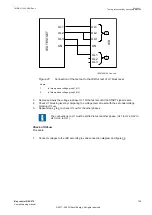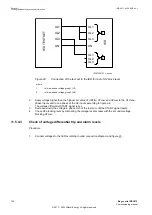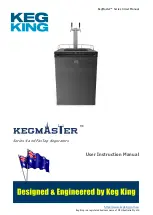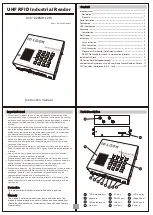
Step no.
Changes after step 2
Expected output
4-e**
Activate binary input TRIGCOMP for 1 s
•
The output COMPEXED
should become HIGH for
100 ms and LASTCOMP
output should display the
date and time of
compensation
•
URATIOL1 and
USEDURATL1 should
show 0.382
•
DIFURATL1 should
become LOW
WARNING signal test
4-f
Inject U
TapL1
= 23.04 V in secondary at rated
frequency
•
WARNING and WRNL1
signals should become
HIGH after a time delay
given by the setting
tDefWrn
•
PUDIFL1 should show 5.03
%
ALARM signal Test
and
4-g
Inject U
TapL1
= 22.31 V in secondary at rated
frequency
•
ALARM and ALML1 signals
should become HIGH after
a time delay given by the
setting
tDefAlm
•
PUDIFL1 should show
8.04%
TRIP Signal Test
4-h
Inject U
TapL1
= 21.83 V in secondary at rated
frequency
•
STARTBFI_3P and STL1
signals should become
HIGH after a time delay
given by the setting
tDefTrip
•
TRIP and TRL1 signals
should become HIGH, if
BlockTrip
is set to
Trip
enabled
•
PUDIFL1 should show
10.01%
- Steps 4–f, 4–g and 4–h can also be done phase wise.
* - UBase is considered as 400 kV and VT ratio as 400 kV/110 V
The voltage inputs U
L1
, U
L2
, and U
L3
refer to the bus voltages and U
TapL1
refers to the tap voltage of
phase L1.
** - This step should be done only during Factory Acceptance Test (FAT). At field, the testing should be
done with the stored field values.
To calculate PUDIFL1 in steps 4-f, 4-g and 4-h, use the following equations:
1
1
1
1
1
L
TapL
UDIFL
U
U
USEDURATL
IECEQUATION19217 V1 EN-US
(Equation 30)
1MRK 511 403-UEN Rev. L
Section 11
Testing functionality by secondary injection
Bay control REC670
137
Commissioning manual
© 2017 - 2022 Hitachi Energy. All rights reserved
Summary of Contents for REC670
Page 1: ...Relion 670 SERIES Bay control REC670 Version 2 2 IEC Commissioning manual ...
Page 2: ......
Page 28: ...22 ...
Page 54: ...48 ...
Page 60: ...54 ...
Page 66: ...60 ...
Page 90: ...84 ...
Page 212: ...206 ...
Page 218: ...212 ...
Page 232: ...226 ...
Page 240: ...234 ...
Page 241: ...235 ...
















































